Posted by Paul Smith on 05-16-2008 10:57 AM:
Tekke main carpet
Greetings, Turkotekkers!
I just acquired this Tekke main carpet and
wondered if anyone had a sense of its age...I apologize for my inability to find
a place where I could get far enough away from it to get a clear straight-on
image of the entire rug. And I haven't washed it yet either...

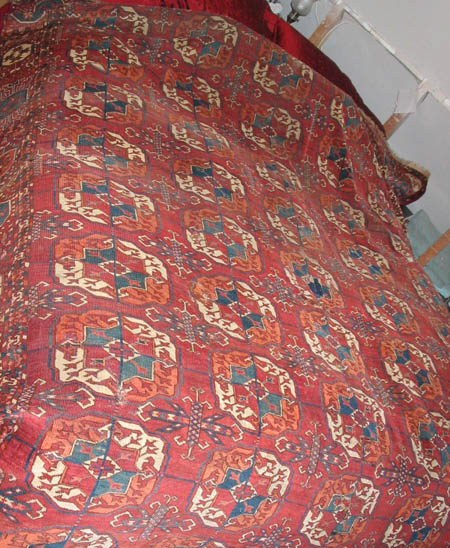
Some detail images,
too--
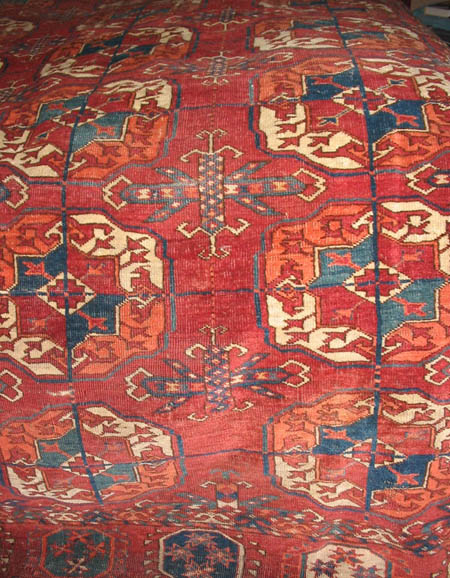
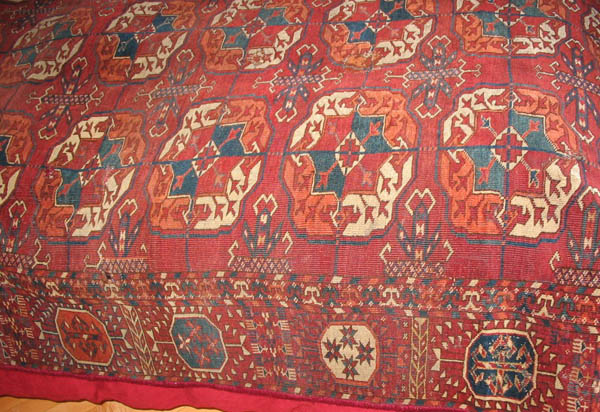
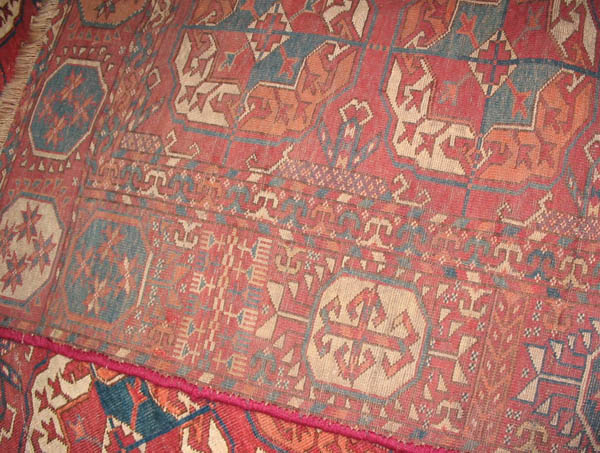
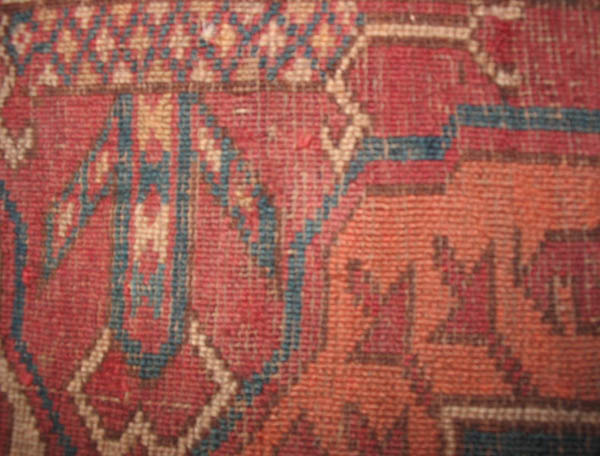
The knot density is c. 144 per inch (16h x 9w), and there is a
bit of pale yellow details in it. In the lower right quadrant there are vertical
dotted lines connecting the minor guls. I love the border, with all the little
elements between the octagons, and the use of both four stars and a few crosses
in them.
Obviously there are some condition issues, mainly in the center.
Since I'm going to hang this, I was assuming the right thing was to find
appropriate colors of linen fabric to back any holes (should I remove any
patches of other carpets?). On the selvedges, it has that ugly overcasting, and
it appears that I've lost the last quarter inch or so on the sides. I was
thinking of removing that overcasting, but if there is no real selvedge there,
is that a good idea? Any advice on how to approach the condition issues would be
very appreciated...
Thanks!
Paul
Posted by James Blanchard on 05-16-2008 10:09 PM:
Hi Paul,
That is a grand carpet. It should make quite a statement on a
wall. I am not the one to comment on age, but to me it looks "old
enough".
One detail that struck me for some reason was the presence of
"crests" on a few of the "bird" figures in the main guls. I have seen that in
the main guls of the Ersari and some other Turkmen groups, but somehow don't
seem to associate that with the Tekke gul. I haven't snooped around for other
examples. Perhaps others could comment?
James
Posted by Martin Andersen on 05-17-2008 02:17 AM:
Hi Paul and James
Exactly my own thought on the “Crests” or “Horns”. I
haven’t seen them on the main gull before, they are normally on the chuval gull.
And they actually look very beautiful here on the main gulls, they give a
strange kind of grandeur to the drawing.
"crests" or
"horns"
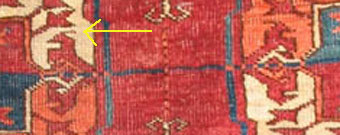
Regarding the age I probably know no more than yourself. But in
general: The roundness of the main gull, the squareness of the border octagons,
the stars in the octagons and the limited amount of surrounding borders goes for
ages. And the 5 rows of main gulls and the tallness of the carpet go a bit
against age. My own conservative guess on the age would be 1875 +/- 25years, but
that is certainly just a guess.
A beautiful carpet.
Regards
Martin
Posted by Richard Larkin on 05-17-2008 10:39 AM:
Hi Paul,
Wonderful rug. You're right, the detail and scale of the
various doodads in the border is great. Judging by the way it drapes, the handle
looks very good, too. Excellent color. A fine candidate for the "Save the Orange
Committee."
I will leave the age parsing to more qualified persons, but I
think James hit the nail on the head, "old enough." As far as the crests on the
birds is concerned, very interesting. It seems that the opposing bird in a pair
has the crest. Are we opening an ornithological can of worms? (Please excuse the
mixing of metaphors.)
I would definitely leave the patches alone. Are any
visible in the images you posted? As to the selvages, I doubt there is anything
more frustrating to find in a good old in a rug than that some troll of the past
chose to cut the (presumably compromised) original selvages back to the nearest
available straight line. The outrage is compounded when the cut is then covered
clumsily and in the wrong color. (Although that might be preferable to
that ubiquitous machine serged, light purplish gray overcasting one finds so
often.) Still, I would be reluctant to remove the overcasting now, unless I were
getting comprehensive restorative treatment for the rug. In spite of my remarks,
it doesn't look bad.
Are there any top notch rug cleaning specialists in
Washington State? Speaking as a driveway washer of numerous rugs, I would
approach this baby with the utmost care and caution. Whatever you do, enjoy it.
__________________
Rich
Larkin
Posted by Paul Smith on 05-17-2008 11:11 AM:
Martin, James, Rich...
Thanks for your observations!
"Old
enough" is exactly what made me jump on this one! I don't think this one is that
"tall" though--85"h x 77"w. I think this one must have had the standard red with
blue stripes kilim ends. I hadn't placed what exactly was different about the
guls, though...
Rich--
In the image with the carpet on the bed,
right in the middle you can see an odd blue patch in the middle of one of the
guls--2" x 2". I will leave it undisturbed, then...I know of a high-quality
carpet washing outfit in Seattle, but I was thinking of tackling it. My current
method is to make a huge tub with a clean tarp and sides of 4x4s, I fill it with
the garden hose, and I can let down one of the sides to let out water during the
interminable rinsing. I would do the Orvus treatment and I have a very soft
paintbrush with which I can very gently work the pile. In spite of a few holes,
a couple patches, etc., most of the carpet is very solid. Most of it seems
nearly full pile, actually.
Posted by Richard Larkin on 05-17-2008 11:25 AM:
Hi Paul,
Yup, I see the patch. I'd leave it be. If you do the washing
yourself, your method sounds right. It is hard getting the imbeded dirt out
thoroughly without stressing the rug. Full rinsing is very important. Top line
competent rug cleaners have equipment designed to do these things effectively,
and know what can be done safely.
__________________
Rich
Larkin
Posted by Martin Andersen on 05-17-2008 01:44 PM:
Hi All
I hope someday someone will try to make a public database with all
these beautiful carpets. A database were one could make cross references over
design variations, structural info, and perhaps estimated age. It is provoking
how close - and yet far from each others these highly disciplined carpets
are
Regards Martin
Posted by Jim Allen on 05-19-2008 02:22 PM:
Main
This 5 X 9 format, assuming it isn't cut, is inordinately rare. This makes it
older rather than later to my thinking. Jim
Posted by Paul Smith on 05-19-2008 04:52 PM:
Hi Jim--
Thanks, I was hoping you would check this out...The rug is
absolutely not cut, though it has losses to the sides and ends. And it's much
cleaner today after washing, too!--a river of frothy mud seemed to come out of
it! I am curious how old you think it might be, only because I notice that
experts seem pretty confident about figuring the age on Turkmen carpets:
mid-19th, c. 1880, etc., as opposed to the vagueness on age of Baluch rugs, for
example.
Paul
Posted by Jim Allen on 05-19-2008 07:22 PM:
strange main
I haven't seen the paddles or radiata separated from the octagon of the main
border....see how these lift off forming an ovoid shape of boat or gull paddles!
This is the second rather unique feature I have noticed. Usually when I see so
many of the "paddles" I think a later dating but this one is too strange and I
suspect it is mid 19th century. Jim Allen
Posted by Paul Smith on 05-19-2008 08:52 PM:
Jim--
I see what you mean. They look a little like fish skeletons. I
appreciate your taking a look at the piece...It seemed so beautifully
proportioned with such interesting drawing. Throughout the carpet there are
constantly shifting little design details that seduce the eye. Such powerful
colors. It sure seemed like an old one, but I lack your experienced eye. I love
these old Tekke main carpets, but I thought I would never be able to afford
anything like this and all of a sudden there it was at precisely the moment when
our government told us we needed to spend our tax rebates. It was my patriotic
duty to buy this rug.
Paul
Posted by Alex Wolfson on 05-19-2008 09:33 PM:
Well done, that's a real find!
In my humble opinion I would propose a
mid-19th century date, based on the apparent handle of the rug as well as the
design. The border octagons for example seem quite freely drawn and widely
spaced, with colors that apparently alternate at random.
Posted by Martin Andersen on 05-20-2008 01:14 AM:
Hi Paul
Hope you will post a few photos of the colors after
wash.
Regarding age of these rugs there seem to be rather big differences in
how the experts date them in the literature. I suppose the difference between an
Azardi and a Pinner dating could easily be 100 year? But then again it may just
be me who fails to understand their specific criteria’s .
Regards
Martin
Posted by Steve Price on 05-20-2008 05:44 AM:
Hi Martin
Date attribution is often based on intuition and on
marketplace lore. There isn't much of a database of rugs of any genre that can
be documented to be more than 125 years old, so how could anyone develop
criteria based on the physical characteristics of such rugs? This doesn't even
slow down the pseudo experts who insist that their attributions are infallible,
of course.
Pinner was pretty conservative about date attribution, Azadi
is very aggressive about it. Turkmen pieces predating the 19th century are
generally considered to be extremely rare; a decade ago, many thought they were
essentially nonexistent. In Wie Blumen in der Wuste, Azadi attributed a
significant percentage (my recollection is that it was around 20%) of the rugs
in the exhibition to the 18th century and earlier. Even if he was right (maybe
he was, maybe he wasn't), an intuitive attribution doesn't rest on solid
ground.
Regards
Steve Price
Posted by Jim Allen on 05-20-2008 03:44 PM:
Tekke Main
I have to admit I just now realized how spaciously the octagons are arranged
in the top and bottom borders. There is a lot more free undecorated space than
usual. This rug is certainly from before the prolific period and looks to be a
fine collector's piece. From the look of it I bet it was a spanking good deal to
boot. Jim Allen
Posted by Paul Smith on 05-20-2008 04:12 PM:
Everyone--
Here is an image of the cleaned rug, though I don't find
that it does much better than the other images in capturing what this rug really
looks like, even though the colors have intensified. The frustrating thing is
that the red I see in the actual rug has a definite purplish shade to it, but it
sure looks more tomato-ish in these images. I think the flash and my wimpy
little digital camera are the problem...
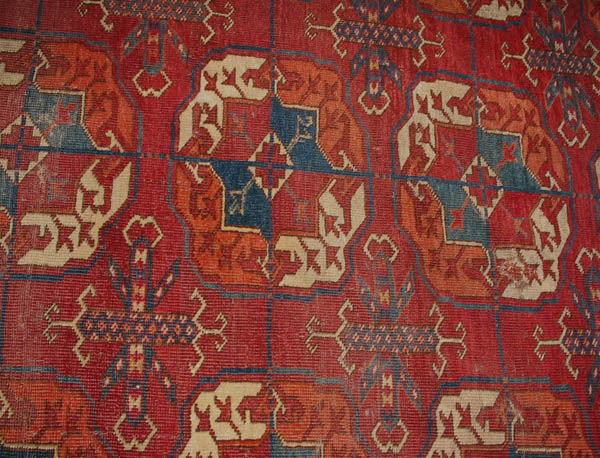
I understand about the
difficulty in providing accurate age information, but on the whole there seems
to be more of a sense of accuracy in 19th-c Turkmen rugs and weavings than in
many others, notably those wacky Baluchis. Before 1820 or so it all seems to get
substantially more vague, certainly. I had always understood that dating
Baluchis were a problem because there weren't many acquired in the West until
the latter 19th c., and somehow I thought that was in comparison with the
much-better-documented early Turkmen acquisitions in the West. It is part of my
lore as a Baluchophile, isn't it? And proof I can even work a Baluch reference
into a thread about my own Turkmen rug...

But, aside from the really early
Turkmen rugs which may or may not be as ancient as we would all sort-of wish
they were, aren't there examples from the early and mid 19th c. that are nailed
down with historical evidence?
Paul
Posted by Steve Price on 05-20-2008 06:09 PM:
Hi Paul
I don't think there's a single Turkmen pile weaving that can
be documented to have existed before 1875, although C-14 dating shows several to
be much earlier than that. The casual ease with which people attribute Turkmen
textiles to windows of 25 to 50 years going back to the 18th or even to the 17th
century can give the impression that someone REALLY knows. Sadly, that's not the
case.
Regards
Steve Price
Posted by Paul Smith on 05-20-2008 07:29 PM:
"sadly"?
Hi Steve--
I guess it's sad, in a way. For scientific certainty it's a
deal-breaker, but in a more positive light it does bring aesthetics to the
foreground. We clearly can intuit that we must be looking at a bunch of rugs
predating 1875, but the only way to try to sort them out is through observing
and handling them. Added to that is the insurmountable obstacle of knowing so
little of Turkmen (or Baluchi, or...) culture before 1875. Still, a pretty
seductive mystery!
Paul
Posted by Steve Price on 05-20-2008 08:22 PM:
Hi Paul
We clearly can intuit that we must be looking at a bunch of
rugs predating 1875, but the only way to try to sort them out is through
observing and handling them.
I'm not convinced that all the observing
and handling in the world will give reliable date attributions in the absence of
standards - pieces of documented ages, in sufficient numbers to make
generalizations possible.
Regards
Steve Price
Posted by Sue Zimmerman on 05-21-2008 10:44 AM:
I'm convinced that in Tekke weavings generally thought of as being made in
the third quarter of the 19c as opposed to those generally thought to be made
mid-19c there is a very easily visible falling away from higher quality wool
processing post mid-19c.
This can be most easily seen by comparing them, from
their backs, under x10 magnification. Focus on their yarn's loose fiber ends.
It's easy and you don't even have to know why they are so different to notice
the difference. Sue
Posted by Steve Price on 05-21-2008 11:07 AM:
Hi Sue
The issue isn't whether differences exist between Turkmen rugs.
Clearly, they do. The question is, on what basis do those differences become
reliable criteria for age attribution. Let's suppose that the difference you say
that you observe is real (and I have no reason to think it isn't) - some rugs
have wool that has been processed better than others. How do you know that those
in which the wool processing is better are older, rather than younger or of the
same age? This is, in my view, the crux of the
matter.
Regards
Steve Price
Posted by James Blanchard on 05-21-2008 11:10 AM:
Hi Sue,
Does this correlation imply that we can generally rely on
current approaches to establishing the relative age of Tekke weavings?
James
Posted by Sue Zimmerman on 05-21-2008 11:15 AM:
Steve, Because it's just one of many symptoms of systemic collapse.
Posted by Steve Price on 05-21-2008 11:38 AM:
Hi Sue
If there was a modest database of Tekke rugs with documented
ages and somebody found a high correlation between age and quality of wool
processing or, even better, a narrow range of ages during which processing went
from wonderful to lousy, this could be a neat criterion for date attribution.
But I see nothing implausible about the notion that two lots of wool could be
spun at different levels of quality at more or less the same time or that
spinning quality could have varied between high and low many times in history.
Without addressing those issues, the argument comes awfully close to, "I like
old rugs better than I like new rugs. I like rug A better than I like rug B.
Therefore, rug A is older than rug B."
Regards
Steve Price
Posted by Sue Zimmerman on 05-21-2008 11:54 AM:
James, I don't know. There are many, many reliable ways of figuring these
things out. I'm just telling of one little thing you can see for yourself if you
want to not have to depend on other's for such things. It's almost too easy,
frankly.
Posted by Sue Zimmerman on 05-21-2008 12:10 PM:
Steve, I'm not talking about good vs. bad spinning. Just get out your
magnifier and look. If you don't want look to you won't be able to know what I'm
talking about. Those who do will.
Posted by Richard Larkin on 05-21-2008 12:10 PM:
Hi Folks,
Steve is right about this. I remember somewhere in Edwards
book, The Persian Carpet, he mentions that some particular rug design got
its popularity due to the diligence and energy of a town mayor's spouse. That
has nothing to do with the age of Turkoman rugs, of course, but it is a little
factual event that echoed down the ages of rug weaving, and we are looking at
the results today. But for Edwards mentioning it, I doubt we'd have known about
it.
My belief is that hundreds, probably thousands of little events
occurred here and there in the history of rug weaving, that changed the face of
the craft. Some changes were profound, some slight, most in between. I don't
think we know nearly enough of them to build a framework within which we can
arrange the rest in order to create reliable models for accurate pronouncements
about all of the rugs out there. This is true for age, provenance, and design
adoption or migration. Thus, Sue's point about the observable difference in wool
qualilty among Tekke rugs may well be true; and her hypothesis that it is
diagnostic for age is quite reasonable. But it is only a hypothesis; and when
one hypothesis is stacked on top of another in this way in order to answer the
questions we ask about the rugs, the answers become less and less
authoritative.
There's nothing wrong with pursuing these analyses as well
as we can. Where the rub comes in, as Steve aptly points out, is when the
resulting opinions about, e. g., age, are asserted as though they were proven
facts.
Posted by Steve Price on 05-21-2008 01:22 PM:
quote:
Originally posted by Sue Zimmerman
Steve, I'm not talking about
good vs. bad spinning. Just get out your magnifier and look. If you don't want
look to you won't be able to know what I'm talking about. Those who do will.
Hi Sue
I'm not questioning the accuracy of your
observation that there are differences among Tekke rugs that can be seen under
10x magnification. What bothers me is the assertion that they are highly
correlated with age and, for that reason, are reliable criteria for age
attribution.
Steve Price
Posted by Sue Zimmerman on 05-21-2008 02:57 PM:
Richard, I'm not talking about wool quality. Once again, and I thought what I
said was clear the first time, look at the ENDS of the fibers under 10x
magnification.
Posted by James Blanchard on 05-21-2008 03:29 PM:
Hi Sue,
You all know that I am relatively new to this whole interest
area, but in my limited view I don't see many reliable ways to "figure these
things out". If there were, I suppose we wouldn't have so much discussion and
debate about the age of weavings.
Frankly, it would be very heartening to
have a simple, physical assessment tool that could accurately and reliably
determine even the relative age of old weavings. So if your hypothesis about age
and wool quality is correct, and the visual test is sensitive and specific, it
would offer a nice option for both dating weavings and to examine some of the
conventions in dating based on other criteria such as design. Now all we have to
do is validate the method, or have some solid documentary evidence that
observable changes in wool quality occurred during a specific
era.
James
Posted by Steve Price on 05-21-2008 03:40 PM:
quote:
Originally posted by Sue Zimmerman
Richard, I'm not talking
about wool quality. Once again, and I thought what I said was clear the first
time, look at the ENDS of the fibers under 10x magnification.
Hi Sue
Unless there's something like a weaving date
attached to those ends, I don't see how looking at them tells anyone how old the
rug is. And if you weren't talking about wool quality or spinning quality or any
other kind of quality, what the hell did this mean?
... there is a very
easily visible falling away from higher quality wool processing post
mid-19c
Steve Price
Posted by Paul Smith on 05-21-2008 05:56 PM:
Steve's insistence on scientific standards being applied to scientific
questions is pretty hard to argue with, and I'm sure that if someone really had
a method as Sue described, in which aging of wool fibers can somehow be observed
in a testable, measurable way, their work would revolutionize the analysis of
antique woolen textiles. They could publish fabulous rug books dating great rugs
until the end of their days. They would have a job in which acquiring fabulous
rugs was a business expense.

What I was trying to say awhile back was that without a
scientific method to date carpets (as it seems we don't actually have), specific
accurate dating won't happen...agreed...but, when I said that observing and
handling is all we have, the sorting I was talking about wasn't to place
specific dates but to get a sense of relative ages or different traditions or
groups of weavers. What information IS available through the methodologies we
have? Well, for someone like me, it is to trust to some degree the knowledge of
people who know a lot more than I do.
It seems that people who have
"observed and handled" many, many rugs, read lots of literature, and engaged
actively in what seems from the outside to be a fairly disorganized community of
experts in the "field", do acquire an intuitive command of knowledge, that their
evaluation of a given carpet's age in the context of other similar weavings,
while not scientific, is not entirely without merit.
Paul
P. S. I
am a fan of the T'tek editing capabilities but because Steve (below) responded
to something I wrote and then later edited out (because it seemed more
confrontational somehow than I really felt), I should say that I indeed ended an
earlier version of my post with--Don't you think we know more than "before 1875
but probably after 1700," even without scientific data?
Posted by Martin Andersen on 05-21-2008 06:25 PM:
Hi Steve, Paul and All
I understand that all precise dating of these
carpets for now (and perhaps forever) is speculative. And dating by design alone
is of course also very speculative. But on the other hand you dont have to look
very long at them until you get a felling of being able to place them in some
kind of succession or by the deterioration of their layout. A felling which of
course may be completely wrong, and partly based on lore, but the carpets did
develop from at least the 19th to the 20th, and I would find it strange if
people were not trying figure out in what order that development went.
In
general I suppose its is obvious that the Tekke design roughly is going from
something like this:

to this:
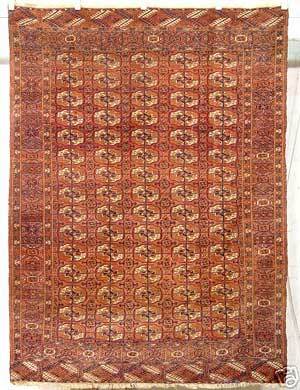
And I suppose when the marked or people in this forum date a
rug mid 19th, they are trying to place the dating somewhere in between these
positions. And these positions certainly represents several generations of
development. The daughter of the first carpets weaver could not have weaved the
second.
I know of course it would be speculative and a simplification,
but I would still think that in time it would not be completely impossible to
establish a morphologic and nuanced layout succession of the main carpets. I
suppose we are all actually doing that in our personal perception of the
carpets. But, Very old, old, old enough, late, very late, and to late - might be
the appropriate terms for now
regards Martin
Posted by Steve Price on 05-21-2008 06:26 PM:
Hi Paul
Don't you think we know more than "before 1875 but probably
after 1700," even without scientific data?
Not with a very high level
of certainty. All the sorting and handling won't give you or anyone else
relative ages, only the impression of relative ages based on what someone told
you were characteristics specifically related to age. Unless they or their
mentors were clairvoyant, there's no assurance that what they taught you was
much more than errors solidified by repetition. Those who "know a lot more than
I do" probably do know a lot more than I do, but not all of what they know is
right.
Tekke weavings from the late 19th century to now are pretty well
documented. It's the earlier one that are troublesome.
Regards
Steve Price
Steve Price
Posted by Sue Zimmerman on 05-21-2008 06:40 PM:
Steve,
There is far more to processing than spinning. I know, first hand,
that the earlier higher quality standard is, and was, vastly more expensive, and
vastly more time consuming. The later lesser corner cutting processing is
compensated for, in the post-mid 19c Tekke weavings I've seen, and can be known
for what it is.
For anyone who decides to look for themselves it probably
won't take more than fifteen minutes per rug to get it. I'm just passing the
info on to collectors who have stated an interest in the matter because I think
it's the right thing to do. I have no interest in discussing whether or not it's
worth the few minutes it would take to check out. That would be silly. Sue
Posted by Richard Larkin on 05-21-2008 08:38 PM:
Hi Folks,
Even if we establish well observed and documented criteria
to differentiate Tekke main carpets in terms of wool and dye quality, drawing,
fidelity to traditional designs, weaving skill, etc., characteristics often used
to assign age to rugs, it is a gratuitous assumption that they necessarily
developed in a single continuum of weaving. Turkoman tribes as weaving blocs are
frequently, if not exclusively, spoken of as monolithic weaving communities; but
I do not know that such a proposition can be sustained by historical evidence.
Is it possible that weaving in various sectors of the greater Tekke "nation"
proceeded in different qualities that would belie the assignment of age based on
"development" (or deterioration) of quality?
__________________
Rich
Larkin
Posted by Steve Price on 05-21-2008 10:12 PM:
Hi Sue
You seem very confident that higher quality, vastly more
expensive processing is a reliable indicator of pre-1850 Tekke weavings and that
the processing quality is lower in post-1850 Tekke weavings. Unless you have
observed this in a fairly large number of Tekke rugs that are documented to come
from both age groups, you are just assuming that Better = Older. Since there are
few, if any Tekke rugs documented to have been woven before 1875 except for the
handful that are C-14 dated to 1700 and earlier, you cannot possibly have made
the observations necessary to reach the conclusions that you
present.
Steve Price
Posted by James Blanchard on 05-22-2008 03:25 AM:
Hi all,
I only have a few Tekke weavings that might be from the 19th
century, so I couldn't do much of a comparative analysis using Sue's
method.
However, I will assume that Sue is correct and there are
noticable qualitative differences in wool between different Tekke weavings. For
this to be an accurate and reliable indicator of age, I would look for the
following:
1) The method can be compared against Tekke weavings of known
age. Steve has expressed his views about the lack of a reliable database with
this sort of information. If the comparison rests on currently accepted criteria
(like design, drawing, colours, etc.) then that would suggest that those
criteria are sufficient for age attribution, which would make Sue's approach
interesting but of limited added value for dating rugs per se.
2) The
decline in wool quality would have had to occur over a defined period of time
and for defined weaving groups (Tekke, in this context). Sue, do you have any
other corroborating information that indicates when and why the wool processing
for Tekke rugs changed? Is there evidence to suggest that this occurred
uniformly across the Tekke weaving groups?
I would like to reiterate that
I am not skeptical about Sue's observations of variability in wool quality. It
makes sense to me that there was a time period during which wool processing
changed due to ethnocultural and economic changes. We certainly know that this
happened in relation to the design and knotting of rugs. What is less clear to
me is whether these changes can be accurately and reliably ascribed to a
specific time period, and whether the changes occurred uniformly across tribal
groups and sub-groups. If so, I think this holds some
promise...
James
Posted by Jim Allen on 05-22-2008 10:24 AM:
Tekke Dating
Sue, in my opinion, is basically right about wool quality and age. James B.
made a good point when he suggested that Tekke weaving wasn’t uniform across
their spectrum. In the time period under discussion there were two sub-tribes
(Hotomish & Otomish) living respectively on each side of “the river”. There
were 20 clans under each sub-tribe. It seems quite reasonable that there would
have been quite a large variation from the worst to the best weavers in the
Tekke Nation. The quality of Tekke weavings varied and indeed depended on a
milieu of criticism and appreciation. These two main determinants of quality
were both in retreat, literally under attack, during the 19th century after
about 1820 culminating in their defeat in 1882 at the hands of the Russians.
As Steve has pointed out there is a sort of black hole regarding dating
Tekke weavings from 1700 to 1875, when synthetics started appearing in Tekke
weavings. Taking his logical assertion at face value I predict that a fair
number of Tekke mains are actually from the 18th century and the means for
verifying this are probably already being used. Over ten years ago Nobiko was
talking to me about surface scanning techniques that could be used to infer ages
of dyed wool. People who are responsible for buying and conserving true museum
quality material aren’t relying on some huckster with a big idea. They are using
dye analysis, C-14 techniques, and things I am sure I have never heard of before
but it is foolish to assume that any of us would know about it, unless of course
the person had developed such a technique theirself.
In this regard I
suggest looking closely into Sue’s assertion. I have been looking at Tekke
weavings for years with a ten & twenty power jeweler’s loop and I am
certainly going to look at my earliest Tekke weavings in the way that Sue
proscribed. I already know that the best / earliest Tekke weavings feel better
than anything that looks like late Tekke material…. to me. The tactile
differences are so great it seems certain that visual differences must be
obvious at some level of observation.
It seems quite possible that the
twin drivers of Tekke weaving quality, criticism and appreciation, would have
equally impacted the production of the very finest wool and its spinning. Bear
in mind that during “normal” times the Tekke’s main economic product was wool,
both processed and raw. When times were good for the Tekke they enjoyed the
pastures and waters they felt were the absolute best. I recently had the
privilege of seeing a Turkotekker’s Turcoman collection. In this collection was
a Tekke 6 gull Tekke torba, that I dated to the first half of the 18th century.
I could have made that dating just using Sue’s criterion for wool quality and
age as this torba is made from wool the likes of which I have never felt before.
It felt better than silk.
It is just one more step to draw a linear map
describing the locations and relative prestige or power of the Tekke from 1700
to 1875 and tentatively placing the weavings with the very best wool and color
into those periods of maximum Tekke self determination and power. Of course
aesthetic decisions must be made; as there are nearly half a dozen high points
on this map.
That brings us to the question of how are we to make
aesthetic decisions about what is good and what is old and do these two
categories enjoy a large set union. I think they do. If Sue is right then simple
microscopy set up with the appropriate scales for comparisons plus a camera
should be enough for a dedicated person to build a solid case based on
measurements.
Jim Allen
Posted by Sue Zimmerman on 05-22-2008 10:50 AM:
Jim,
There is no doubt in my mind that the 6 gul torba you speak of was
prime quality Angora Mohair. Sight unseen. Just from what you've said. Sue
Posted by Wendel Swan on 05-22-2008 01:13 PM:
Hello all,
The refrains about associating age with wool quality in
pre-1875 Turkmen rugs are, simply put, folderol. It seems that the proponents
advocate something like a linear declination in wool quality, but where are the
benchmarks? Who established what 1850 wool looks like compared to 1750 or 1650
wool?
The preposterous suggestion is that all one has to do is look
through a microscope. OK, but what does one see? Is the claim that the results
are self-evident? Clearly there would be differences but what is the meaning of
those differences? Who interprets the differences and on what basis? I submit
that the corpus of knowledge on which to base distinctions is
non-existent.
There are too many factors that vary century by century,
decade by decade, and even year by year to draw any such conclusions. Wool
quality can depend, among many other factors, on the breed of the sheep, where
they grazed, the water supplies, when and how the sheep were sheared, which part
of the animal the wool came from, who processed the wool and which tribe or sub
tribe produced the carpet.
Wendel
Posted by Joel Greifinger on 05-22-2008 02:52 PM:
Hi all,
Jim wrote "It is just one more step to draw a linear map
describing the locations and relative prestige or power of the Tekke from 1700
to 1875 and tentatively placing the weavings with the very best wool and color
into those periods of maximum Tekke self determination and power. Of course
aesthetic decisions must be made; as there are nearly half a dozen high points
on this map."
The logic of this step eludes me. Particularly in the light
of Wendel's apposite comments, it is unclear how one would "draw a linear map"
based upon the assumptions that Jim outlines. Even if "criticism and
appreciation" did drive Tekke weaving, and we bracket any aesthetic consensus,
it does not lead us directly to a necessary correspondence between Tekke
"self-determination and power" and "the very best wool and color." Such a
generalization doesn't follow in the aggregate and even less so for any
particular weaving.
Joel
Posted by Jim Allen on 05-23-2008 03:30 PM:
Joel and Wendell:
Drawing a linear/temporal map for the Tekke from circa 1700 to circa 1875 is
a simple graphic exercise. One draws a straight line from left to right labeled
1700 at the origin and 1875 at the end point. One must mark the graph with an
appropriate scale representing the decades of the defined centuries
The
period 1600 to 1675 was one of great desiccation and little differentiation of
iconographies. All Turcoman weavings from this period seemingly show some
relationship to the Salor. The Tekke chuval I had dated, via C-14 analysis at
Arizona University, to circa 1650 had Salor iconography. In the first half of
the 18th century at Khiva the Salor and the Tekke enjoyed the best position and
resources of any Turcoman tribes relative to pasture and water availability.
Isn’t it logical to think that during this time they would have used better
quality wool in their weavings than during times when they were subjected to a
secondary position in the pecking order?
What does one get when one
tries to make a good red color with muddy water? One gets a muddy insincere red
color that isn’t attractive. How many really old Tekke torbas have I seen with
great drawing and crappy colors? A Bunch! I now place all of these second rate
but archetypally drawn Tekke torbas into the time line slot; 1760 to 1790.
During the early 19th century the Tekke 6 gull torba gull changed
slightly. I feel like these early 19th century Tekke 6 gull torba gulls are the
most aesthetically advanced of any group of Tekke torbas. In these torbas the
horizontal bird’s heads have two crests that can also be read as the two feet of
the sacred Tekke bird. The sacred bird’s head, its heart box, and its relatively
large tail are all well represented. These torbas usually show full bows and
arrows at the lateral extremes of their chemche minor gulls.
In my
mind the Tekke torba was simply a useable version of the Yomud asmaldyk. I think
the Yomud asmaldyk’s pentagonal shape was taken from the highest ranking
weavings of the Tekke nation, upon their capture by the yomud at Khiva during
the middle of the 18th century. The small number of Tekke pentagonal weavings
captured from Tekke royalty by the Yomud in the mid 18th century at Khiva later
served as inspiration for a whole new genre of Yomud dowry weaving; that of
purely decorative five sided wedding trappings.
There are perhaps a
dozen or more Tekke 6 gull torbas that modern Tekke connoisseur’s consider being
over 250 years old. At least one member of this set has been dated via C-14
analysis to the mid 16th century. Surely a couple of others will ultimately be
shown to have existed in just a little more recent time.
The reason I
mentioned the set of earliest Tekke torbas is because I am sure a few of you
have examples under your beds.
Jim Allen
Posted by Joel Greifinger on 05-23-2008 07:32 PM:
Hi Jim,
You tell an interesting story, but it doesn't in any way speak
to the methodological issues that either Wendel or I raised. The "linear map"
you propose correlates wool and color quality with Tekke self determination and
power. Substantiating this would entail showing that, in a large selection of
examples, "if A, then B." But you haven't established any independent method for
dating these examples, except for the few C-14 samples. Thus, the logic is
circular: if the wool/color is good, it must be from a Tekke "high point."
Without the independent verification of the age of a substantial sample of these
pieces, we are thrown back on received wisdom and imaginative
reconstruction.
You say, "Isn’t it logical to think that during this time
they would have used better quality wool in their weavings than during times
when they were subjected to a secondary position in the pecking order?" Well,
it's a provocative hypothesis, but you need independent evidence to establish
whether or not it's true. And, more pointedly, are you suggesting that we can
use this to assess individual weavings? Was this better quality wool all that
was being used in the community? Were there other, less propitious eras when
some of this better wool was available to some or saved for particular purposes?
I think the "linear map" you suggest sneaks in lots of unacknowledged and
unsubstantiated assumptions.
Nonetheless, it's a thought-provoking
story.
Joel
Posted by Paul Smith on 05-23-2008 10:47 PM:
I had problems with the idea that for 30 years the Tekke didn't have access
to good water. What do we know about the availability of good water in Central
Asia in the late 18th century? The Little Ice Age was lightening up at that
point, and it is my understanding that rainfall would have been better than in,
say, the 16th century. Surely, there would have been some folks with problems,
and some families with good water, in any case. The other problem we have with
any historical information is that it is all from outsiders, like learning about
the Lakota from General Custer.
Why are we so sure that marketplace lore
is wrong? Aren't there families in Central Asia that have been buying carpets
from Turkmen for centuries? More rare than an early Tekke main carpet are the
dealers or museums presenting their Turkmen pieces as "before 1875." They say
"mid 19th century" or "c. 1800." Are we saying that all of this is bogus? My
personal guess is that you more experienced folks look at a piece and have a
sense of its age, an intuitive appraisal built out of an appreciation of wool
quality, colors, and design. Honestly, when I saw the rug that began this thread
it was clear to me this was an old one, even with my limited experience. I saw
great colors, spacious design with a lot of subtle variation in the little
details, and the way it flopped over a table. It had a yellow. It was five rows
of guls, but they sure looked good. I thought, "Hmm, looks mid-19tb century--I
wonder what the T'tek folks would say."
I was struck today by a report
today on NPR where they were discussing the NOAA predictions for hurricanes this
year. A former director said that "the public likes numbers" and so they try to
predict a certain number of hurricanes, but that the science doesn't give them
certainty on this. The guy said that once a hurricane takes shape, they are
extremely good at predicting where it will hit, however. At this point, we don't
have certainty on dating either, but neither do I think that our ability to
appraise the age of these weavings falls off the edge of the earth at 1875. We
may want numbers, but in the absence of numbers, the experts among us seem
comfortable assigning approximate age to these things. No one said that my
carpet was 18th century, right?
Just to throw a fantasy into the mix,
wouldn't it have been slick for the British East India Company to have equipped
the Turkmen to fight the Russians? The Great Game should have been in
Turkmenistan, not Persia and Afghanistan. Oh well, superpowers seem rarely to
make intelligent decisions about such things.
Paul
Posted by Martin Andersen on 05-24-2008 05:57 AM:
Hi Paul
Sorry for not asking a bit before in the thread, but do you
have a photo of the complete carpet ? I would be very interested in being able
to compare the symmetry or variation of the 2 side borders
elements.
Regards Martin
Posted by Steve Price on 05-24-2008 06:21 AM:
Hi Paul
Patrick Weiler posted a message on a thread in his mini-salon
last night that speaks almost directly to your thoughts. The URL is
http://www.turkotek.com/VB22/showthread.php?s=&postid=29416#post29416
It
contains some quotations from the new book, Timbuktu to Tibet, by Jon
Thompson. Thompson needs no introduction to ruggies, and qualifies as an expert
on Turkmen weavings by anyone's standards. He's talking about Belouch group
tribal attribution rather than Turkmen date attribution, but the problems are
formally identical. Here is an especially relevant excerpt:
... in the
absence of a set of historically reliable attributions it is only possible to
divide carpets into sets according to their observed characteristics, and hope
that at some future time it will be possible to say who made
what.
For those who didn't know, Thompson is as conservative about
age attibution as you might suspect from reading this. For example, he wrote the
catalog for the sale of his collection by Sotheby's around 1994, and made no age
attribution more specific than "19th century". Siawasch Azadi, also a Turkmen
expert by any standards, wrote the catalog for Wie Blumen in der Wuste,
the Turkmen exhibition held in conjunction with ICOC in Hamburg. The tribal and
age attributions are highly specific, and a significant percentage of the pieces
are placed in the 18th and 17th centuries. These cannot possibly be anything
more than seat-of-the-pants estimates; I don't think the first 17th century
Turkmen piece had yet been shown to be that old by C-14 analysis.
So, if
someone is to trust expert opinions, he must decide which expert's opinion to
trust. Thompson and Azadi, both luminaries in the world of Turkmen weaving, can
attribute the same piece to dates that differ by 200 years or more.
Regards
Steve Price
Posted by Paul Smith on 05-24-2008 10:45 AM:
Steve--
Thanks for that link. If there was any group less figured out
than the Turkmen, it must be the "Baluch-group." I feel pretty dense and
obstinate to have pressed these issues, but ignorance is not bliss. And the
confidence of those who give dates to these things is persuasive. So, then, I
guess then the answer really is..."all of this is bogus..."
Martin--
I will endeavor to get high up in the air enough today
to capture this whole carpet in an image.
Cheers--
Paul
Posted by Richard Larkin on 05-24-2008 11:01 AM:
Hi all,
Paul, please observe appropriate safety procedures in getting
"high up" to photograph the rug.
On the question of dating attributions
and known age for some Turkoman rugs: I would think there would be some material
drawn from inventories of wealthy households, in Europe and elsewhere. Does
anyone know of published research along these lines?
__________________
Rich
Larkin
Posted by Steve Price on 05-24-2008 11:04 AM:
Hi Paul
Bogus is a strong word with overtones of ethical judgment. I
think "lacking rigor" is more appropriate. The result is the same, but the
implications about the person making the attribution
aren't.
Regards
Steve Price
Posted by Martin Andersen on 05-24-2008 11:40 AM:
Hi All
Personally I would think was very strange if a few of these
carpets (which obviously must have represented great value for anybody how owned
them- even enemies of the Tekke), shouldn’t have survived from the 18th, or even
perhaps the 17th.
I know of course that there are tons exceptions to the
rules, and that no certainty may be established. But I wouldn’t call it bogus
trying to find out which of these carpets are the old ones, and how they
developed through the generations. Darwin didn’t use c-14 or dates to establish
his no-bogus order of evolution, and his material sure was more complexed than
the Tekke tribe
regards
Martin
Posted by Steve Price on 05-24-2008 12:38 PM:
Hi Martin
I, too, think it would be astonishing if there were no
surviving Turkmen rugs from the 1750-1875 period. In fact, I don't have the
slightest doubt that there are some. There is C-14 data showing that there are
Tekke rugs even older than that, and it's absurd to think that there are none
that are older than the late 19th century but younger than 1750. But I don't
think anyone has a reliable method for identifying the rugs woven around 1850,
1800 or 1750.
Darwin's Origin of Species has several lines of
evidence that evolution happened and that natural selection was the driving
force. He didn't have C-14 dating, but did have a fossil record in which the
relative ages of specimens could be deduced from the depths at which they were
found. He also understood that evolutionary steps weren't leaps, but very small
variations that became preserved and because they were adaptive they eventually
(not suddenly) led to the disappearance of their forebears.
In Tekke
weaving, we know almost nothing about the selective pressures that led to change
except for the development of European markets in the second half of the 19th
century. Jim Allen posits that weavings made during periods of prosperity were
done differently than those made during periods of hardship, for economic
reasons. If he's right, it will complicate development of date criteria, since
the economic condition of the Tekke went up and down many times and was
different in different locations. Organic evolution, at least, is pretty
unidirectional.
Regards
Steve Price
Posted by Martin Andersen on 05-24-2008 02:46 PM:
Hi Steve
It would be nice to try to establish the design of the rugs
around the introduction of the synthetic colours. I do think I have seen rugs
with synthetic colours and all the conventional characteristics of older rugs
than 1875, but with hard definable mechanical expression in the drawing. I
suppose that mechanical expression could be the difference between a workshop
rug and a family produced rug ?
And you are probably right that it’s for
the time being impossible to make a 100 % scientifically order in the rugs (the
Darwin analog was just  ). But
personally I don’t think all knowledge and truth necessarily has to be based
only on science. For example I would say we all could make a qualified guess on
the age of a person and hit +/- 5years (of course there would be exceptions).
This goes for cars too
). But
personally I don’t think all knowledge and truth necessarily has to be based
only on science. For example I would say we all could make a qualified guess on
the age of a person and hit +/- 5years (of course there would be exceptions).
This goes for cars too 
Experience, visual attention and analytic thinking compared with passion for
the rugs, should not be underestimated. I myself am lacking a lot of practical
experience, which I hope to catch up in the next 30 years. Until then I hope to
learn a lot here on Turkotek.
Regards Martin
Posted by Paul Smith on 05-24-2008 02:55 PM:
the whole enchilada
So, I climbed my ladder and fortunately with ten foot ceilings I could just
get far enough away. Reaching out with the camera over the carpet, anchoring
myself against the ceiling...
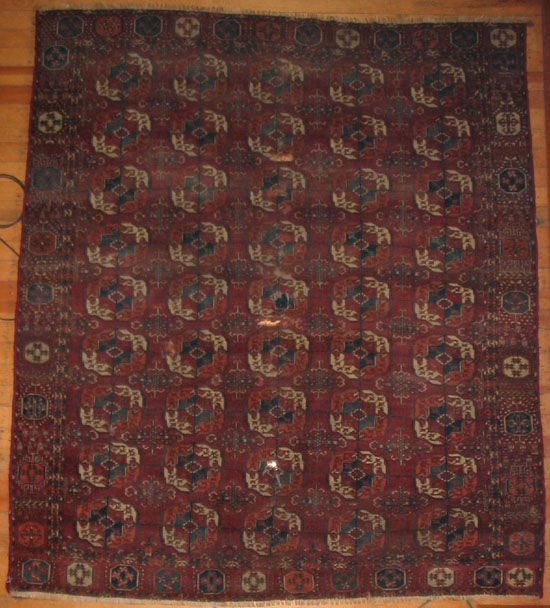
I still have not done justice to the colors, but after ten
tries I at least got the whole thing in the frame. By the way, measuring
carefully for the first time, I found out it is really 92" x 78".
Besides Europeans who acquired Turkmen rugs, are their no people in
Central Asia who have a sense of these pieces? I am surprised that we have a
better understanding of the age of 19th-century Native American artifacts than
the Russians or Bokharans or whoever have of Turkmen material.
Paul
Posted by Steve Price on 05-24-2008 03:20 PM:
Hi Martin
You're 100% right - we can make accurate age estimations of
people, cars, music, architecture; lot of other things, too. In every case, this
is a result of the fact that we have a database from which we learned and
continue to refine our abilities to make the age estimates. For Tekke rugs woven
before about 1875, the database doesn't exist except for a few dated by C-14 to
1750 and before.
I don't like "scientific" as the descriptor for using
reasonably rigorous thinking in arriving at conclusions. "Scientific" implies
using physical, chemical or mathematical methods to reach the conclusions.
Purely historical approaches would work if there was information (reference
standards) on which to base them.
Incidentally, one of the distinguishing
characteristics of scholarly experts is that they know the limits of knowledge
in their subject.
Hi Paul
We know a lot about 19th century native
American material culture because a lot of it was reported and recorded in
situ.
Regards
Steve Price
Posted by Joel Greifinger on 05-24-2008 05:31 PM:
Hi all,
I think Steve has it right. The scientific or bogus choice is
a false dichotomy. What is required is epistemological modesty (i.e. "knowing
the limits of your knowledge), analytical rigor and ongoing skepticism. If you
add in a fairly broad definition of method (i.e. using these to test
hypotheses), you've got my understanding of what constitutes science even
if the evidence is not purely physical or mathematical.
Even rather
far-flung theories, if they are properly qualified, can open us up to seeing
things and making discoveries about the world. What makes this type of
speculation bogus is when it is couched in ways that masquerade as testable
hypotheses or well-founded historical reconstruction.
Paul- The aerial
view even more vividly portrays what a lovely rug you've got there.
Joel
Posted by Richard Larkin on 05-24-2008 05:40 PM:
Hi Folks,
Paul, the rug looks even better than in the other images.
The proportions of it shift my thinking to "older," unscientific as that
is.
There's nothing wrong with attempting to establish models and
criteria for the dating of Turkoman and other rugs. Looking at wool quality,
judging weaving and drawing skill, attempting to reason from ambient
circumstances, etc., are all part of it. We all do it, too, to some extent; or
cabbage onto someone else's having done it. But we have to realize that the
results are not more than educated guesswork.
__________________
Rich
Larkin
Posted by Paul Smith on 05-24-2008 06:15 PM:
Rich, Joel--
Thanks, in that image I got the field color pretty
accurately...deep red, with a hint of purple. As you can see I've got to back a
few holes in the middle. The previous owner must have run his motorcycle through
the center of it a few times. I think that evidence of the motorcycle ritual is
only found in eighteenth-century examples.
Steve--
It is
interesting to me that in the middle of a couple of centuries of cultural (and
physical) genocide, there were enough European-Americans drawn to Native
American culture and artifacts so that there is more of a record of those items.
In addition, it seems that many Native American groups have preserved oral
traditions of their own history so that the events of the nineteenth century are
still accessible to us (at the moment I can't recall the title of a stunning
history of the Battle of the Little Bighorn reconstructed from the oral history
of Native American witnesses).
Where are the equivalent Russian sources?
Surely there were literate commentators in Bukhara or Merv or wherever, and I'm
sure they got some nice carpets over the centuries. Did the Russians more
completely obliterate the Turkmen than we did to Native Americans? That would be
hard to believe.
Paul
Posted by Steve Price on 05-24-2008 06:51 PM:
Hi Paul
The oldest documented Turkmen rugs were collected between 1875
and 1900 by Russian military leaders. The Rickmers collection, the next oldest
in terms of documented collection dates, was collected around 1900.
If
the Russians created trading posts for the Turkmen and kept records of what was
bought and sold, I'm not aware of it. Such records are the foundation of the
ability of today's native American rug dealers and collectors to make rather
fine age attributions with a high level of reliability. Similar records kept by
merchants from about 1875 on are the foundation for our ability to make pretty
accurate age attributions of Turkmen weavings from the late 19th century to the
present time. The oral history passed down through the generations of native
Americans probably doesn't contribute much to present day attribution of the
dating of their antique material culture.
Regards
Steve
Price
Note added, May 26, 2008:
I received an e-mail from Jim
Allen, who knows a lot more about native American rug than I do, which isn't
much beyond what I learned at an exhibition in Denver held when ACOR met there.
An excerpt of Jim's message is:
"The benchmarks relative to dating Navajo
weavings are the introduction dates of different breeds of sheep from the US
government to the Navajo. The simple fact of knowing what breeds of sheep were
introduced when, in the larger scheme of things, allows for the relative dating
of Navajo artifacts via simple microscopic investigations."
Posted by Martin Andersen on 05-25-2008 09:02 AM:
Hi Paul and All
It sure is a very beautiful main carpet with a very
strong appearance.
The two side borders are very symmetrical. All the
octagons, expect a pair in the top, are identical on both sides. And as far as I
can see all the small patterns in between the octagons are also identical on the
two sides. In my understanding, which sure may be wrong, the very old rugs have
very simple drawn border surroundings (which Pauls carpet also have), but they
also have a more asymmetrical variation in both the colours of the octagons, and
even more a lot of asymmetrical variation in the patterns between the octagons.
So I am bit mixed regarding the age of the carpet - but it is of course
certainly old enough
regards Martin
Posted by Paul Smith on 05-25-2008 10:13 AM:
Hi Martin--
You are right about the symmetrical elements in the
borders, including the little details between the octagons. There is some
variation of color in very fine details, as there is in the field, but the
impression is symmetrical. Actually there is more design variation in the
field--I keep finding things as I stare at this, and once I have gotten it up on
the wall I will probably see more. For example, in the first complete row of
minor guls on the bottom in that image, the bottom set of ram's horns are
missing, and in the bottom row of half-guls, the upper ram's horns are in the
blue-green color. There are those mysterious crests in the major guls, and the
dotted lines between minor guls, only on the lower right side of the
carpet.
In spite of very persuasive argument in this thread calling this
into question, I think there is something to your sense (and that of nearly
every writer in the field) that there is a design evolution, as you set out
earlier in very general terms. There are those same sorts of observations over
in your Tekke six-gul torba thread. I am left wondering how these were
formulated, and whether we are seeing differences in tribal subgroups, an actual
change in design preferences over time, or random variation by wacky Turkmen
gals having a party. My guess is that knowledgeable Turkomaniacs that are
reading this thread are not in tremendous doubt about their understanding of how
design, color, and wool quality express age.
Paul
Posted by Steve Price on 05-25-2008 10:45 AM:
Hi Paul
I don't think anyone doubts that there has been design
evolution in Turkmen weavings. The doubts are about whether dates can be
attributed from design (or anything else) on the basis of our current knowledge.
Some experts are very confident that it can, but often disagree about age
attributions (this seems like a big red flag to me). Others are not very
confident, and will only make age attributions of Turkmen weavings in very broad
terms.
Ask 100,000 Christians whether Jesus was resurrected, then pose
the same question to 100,000 non-Christians. You'll get replies of "yes" from
the Christians, "no" from the others. Then ask each respondent whether he has
any serious doubt about being correct. Nearly everyone will answer "no". Half
the respondents are right, half are wrong. None are in doubt.
Steve
Price
Posted by Paul Smith on 05-26-2008 12:55 AM:
I'm struck by Martin's earlier inquiry about the state of Turkmen weaving in
1875. Please squash me like a bug if this is a dumb question, but what are the
earliest rugs like that we CAN put a date to (at least as far as acquisition is
concerned)? Were they already headed towards the squashed-gul, repetitive border
designs he posted earlier? All the Tekke carpets I have seen with synthetic dyes
are of that ilk, though Martin implies that he has seen some with synthetics
that are otherwise of an apparently earlier design. I should say that I have
seen a few late ones with fabulous dyes--no synthetics--and lovely wool (I
posted a small Tekke carpet of mine not long ago like this, when Jim Allen was
asking about small Tekke carpets with the standard main carpet gul).
Paul
Posted by Martin Andersen on 05-26-2008 02:08 AM:
Hi Paul
I think I have found an interesting candidate for a discussion
on synthetics and design in a early main carpet. I will try to post some photos
later.
And love your teori on wacky Turkmen gals having a party 
Regards Martin
Posted by Steve Price on 05-26-2008 06:40 AM:
Hi Paul
Yesterday, three or four messages prior to this one, I
wrote,
The oldest documented Turkmen rugs were collected between 1875
and 1900 by Russian military leaders. The Rickmers collection, the next oldest
in terms of documented collection dates, was collected around
1900.
That's my story, and I'm sticking to it.
The Victoria and
Albert Museum has some Turkmen pieces that they acquired as early as 1875. There
are no earlier acquisition dates known for any Turkmen rug. None. Not even one.
The earliest recorded acquisition date is 1875. That's 1875. That applies to the
V & A, Rickmers, and the Russian generals. No recorded acquisition dates
before 1875 for any Turkmen rug that anyone knows about today.
Some of
the early acquisitions were already worn, even fragmentary. But nobody knows
when the oldest of them were woven, only that it was before 1875.
Elena
Tsareva's book has a number of the pieces that the Russians collected, as do
Oriental Rugs from Pacific Collections and Oriental Rugs from Atlantic
Collections. The Rickmers collection is published, and I'm sure there are
photos of the Victoria and Albert pieces around.
Multiple border
syndrome seems to have arisen around 1900. Variability in the "tallness" of guls
is obvious within the Tekke weavings in the sources I cited.
Oh, did I
remember to mention that there is no record of any extant Turkmen rug having
been collected before 1875? I don't want to leave that out.
Steve
Price
Posted by Yohann Gissinger on 05-26-2008 07:08 AM:
about conservation
Hi everyone,
The questioning of the first post was also:
Any
advice on how to approach the condition issues would be very
appreciated...(??)
Could anyone explain what is the best conservation
approach for such a rug?
Best regards.
Y.
Posted by Martin Andersen on 05-26-2008 07:35 AM:
Hi All
Steve is of course right that there is no 100% certainty
regarding the carpets being older than the day they were bought by the
museums.
But Azadi has a rather good argument that the carpets that were
bought by Victoria & Albert museum in 1876 and Museum für Volkerkunde
Hamburg in 1905 (I suppose through Rickmer?) were acquired as antiques by
experienced people, and that this is confirmed by the condition of the
carpets.
Museum für Volkerkunde Hamburg

Does anyone have a photo
of the V&A carpet ?
Regards Martin
Posted by James Blanchard on 05-26-2008 07:47 AM:
Apples and oranges?
Hi all,
I am glad that Martin posted the carpet from the Hamburg
museum. It illustrates something that I have noticed about Tekke main carpets.
We often talk about them as a relatively narrow class of rugs which differ
chiefly due to their respective ages. However, any grouping of Tekke mains that
have been assessed to be rather old can look very different from each other. In
particular, the shape and height of the guls seem to differ in fundamental ways.
Consider the two carpets below. Are these two part of a continuous age
continuum, or do they come from somewhat different aesthetic pools? To me, they
are more like apples to oranges aesthetically, which might suggest more
complications in the age attribution process.
James.


Posted by James Blanchard on 05-26-2008 07:52 AM:
another one...
Hi all,
Here is another of the "Hamburg class". This is from Jourdan.
He attributes it to the "first half of the 19th
century".
James.
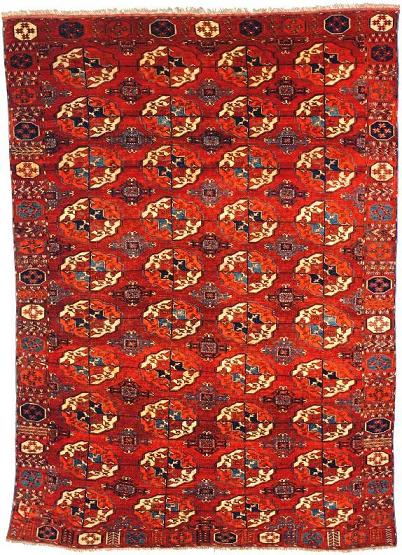
Posted by Martin Andersen on 05-26-2008 08:03 AM:
Hi All
That’s interesting. This one has very symmetrical side border
elements - so there goes one of my previous posted criteria’s for age. What a
mess
Martin
Posted by Steve Price on 05-26-2008 08:07 AM:
Hi Martin
You wrote,
Steve is of course right that there is
no 100% certainty regarding the carpets being older than the day they were
bought by the museums.
I wrote no such thing. I am 100% certain that
those rugs were older than the date at which they were acquired. We don't know
how much older, so we don't know the actual ages of the rugs.
Let's
assume that Azadi is right, some of them were antiques (whatever that term meant
around 1900) at the time they were acquired. It still leaves unanswered the
question of how old they were. Twenty-five Years? Fifty? One hundred? Five
hundred? The bottom line is that we don't have a single Turkmen rug of known age
that can be documented by any method (historical record, physical or chemical
properties) to have been woven at a more or less specific time prior to 1875
except for the small number that have been C-14 dated to predate 1750.

Steve
Price
Posted by Martin Andersen on 05-26-2008 08:15 AM:
Hi Steve
Sorry for misinterpretation you, hope it wasn’t me making you
banging your head against the wall.
These carpets which are c-14 dated
1750, do you have photos or a link to them?
regards Martin
Posted by Steve Price on 05-26-2008 08:34 AM:
Hi Martin
This whole thread is making me bang my head against the
wall. I'm having a hard time digesting the difficulty people have in accepting
the notion that it's impossible to construct a calibration curve relating date
of weaving to rug characteristics without any rugs of known age within the range
of interest.
Jim Allen has one of the C-14 dated juvals, maybe one or two
other pieces as well. I'm sure he knows about the majority of the C-14 dated
Turkmen rugs, and may have photos of some that he can post.
Steve
Price
Posted by Martin Andersen on 05-26-2008 08:57 AM:
Hi Steve
I have seen photos of Jim Allan’s chuval, I thought that you
were referring to c-14 dated main carpets.
I sure think you have made
your point very clear that the dating of the carpets is highly
questionable.
But I don’t hope you think it of topic for this forum to
discus criteria’s for the design development of the carpets? And I suppose
development does imply speculation on what came first, and thereby age. A
discussion that may be rather speculative, but personally I find it eye opening
regarding the carpets. Anyway it is little fun discussing 2+2=4.
Regards
Martin
Posted by Steve Price on 05-26-2008 09:51 AM:
Hi Martin
I don't know if there are C14 dated Turkmen main carpets,
but Jim probably does know.
I think discussion of criteria for
recognizing and interpreting evolution of design in Turkmen carpets is more than
legitimate, I think it's interesting. Using that to assign dates to Turkmen
weavings is dicey if the goal is reasonable certainty within a narrow window of
time (say, 25 to 150 years).
The resistance to accepting the fact that
experts are often basing their opinions, expressed with airs of great certainty,
on little more than marketplace lore strengthened by long repetition puzzles me.
The argument that "every expert and near-expert does it" as a justification has
been repeated here several times. The mere fact that experts often disagree, in
extreme instances by more than 200 years, suffices to demonstrate that certainty
is unfounded. Of course, there are self-proclaimed experts who take the position
that anyone who disagrees with them isn't really an expert. That's convenient,
but stupid.
Steve Price
Posted by Paul Smith on 05-26-2008 10:06 AM:
Bang not thine head, my son
Steve--
You seem to have misunderstood my last post. In no way was I
trying to place a date before 1875. I'm there, dude...totally. If you thought I
was continuing to ask the same question, I can understand your frustration, but
I really really was not doing that. 
What I was asking about was what the actual rugs collected at
that time looked like. And I was also wondering what rugs actually made around
1875 looked like.
...and there was the question about conservation that
Yohann mentioned...
What I am leaning towards doing is taking red linen
and backing the all of the holes but one with that, and then using blue-green
linen for the one hole that is in that part of a major gul. The ends have
already been whip-stitched and I will take Rich's advice to leave the
overcasting alone. I am going to try the velcro hanging method.
I will
also take Rich's earlier advice on leaving the patches. I wonder what state a
weird repair has to be in before you should pull it out and put in linen backing
instead. There are a handful of places on this rug where someone stitched
roughly across a small hole. All of the existing repairs are pretty solid,
though, so I suppose they should be left alone.
Paul
Posted by Steve Price on 05-26-2008 10:56 AM:
Hi Paul
Approaches to conservation are more a matter of taste than
anything else. I've seen a number of old Turkmen rugs with red cloth backings
holding them together, and always thought that was an attractive
treatment.
A number of the Turkmen rugs collected before, say, 1910 are
published in sources cited above. One thing to bear in mind when you look at the
photos: they not only represent rugs made before about 1875, they also represent
the tastes of the small number of people who bought those rugs. The Dudin and
Bogolyubov collections reflect the preferences of two Russian generals, the
Rickmers collection was entirely purchased by Willy Rickmers, a German
businessman. They are unlikely to be a random sample of Turkmen weavings of
their periods even if we knew what those periods were.
My apologies if I
sound pessimistic about the likelihood of being able to accurately attribute
Tekke rugs (main carpets or anything else) to reasonably narrow date windows on
the basis of the resources that have come to light so far. The Turkmen would be
more lovable if they inscribed dates on their rugs. Then, all we'd need to worry
about is whether the dates were the dates of weaving and which calendar was
being used.
Regards
Steve Price
Posted by Martin Andersen on 05-26-2008 02:15 PM:
Candidate for early synthetic main carpet ?
Hi All
In my understanding, which as usual may be wrong, synthetic
colours like fuchsine would earliest be found in Turkmen rugs around 1860, and
then only in small quantities. It was abandoned commercially rather quickly
around 1890-1900 because of its low quality, and tendency to fading and
bleeding.
Much of the red in this carpet to my eye looks like it’s far beyond
madder. Some of colours are drastically faded, and there are small spots of
bleedings from the hot red. But again I may certainly be wrong
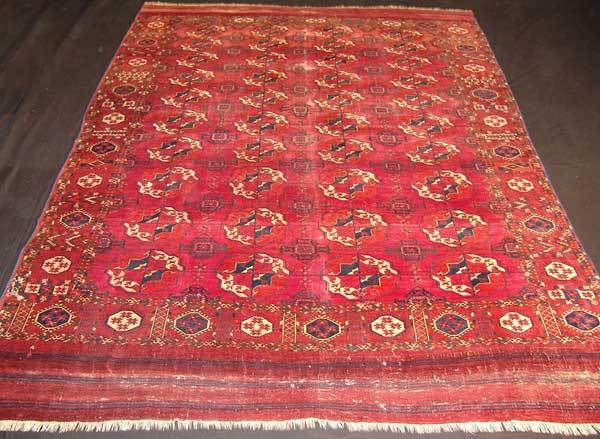
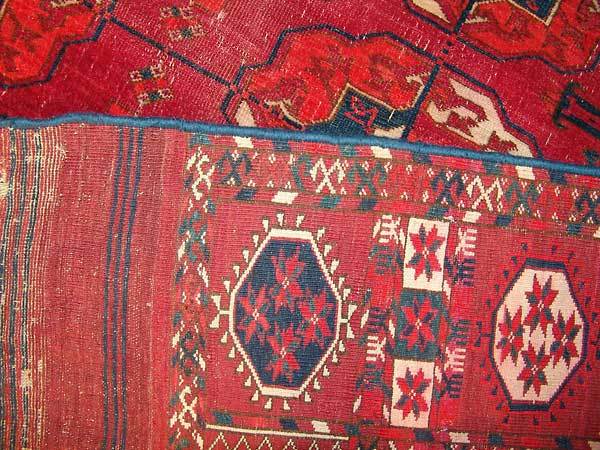
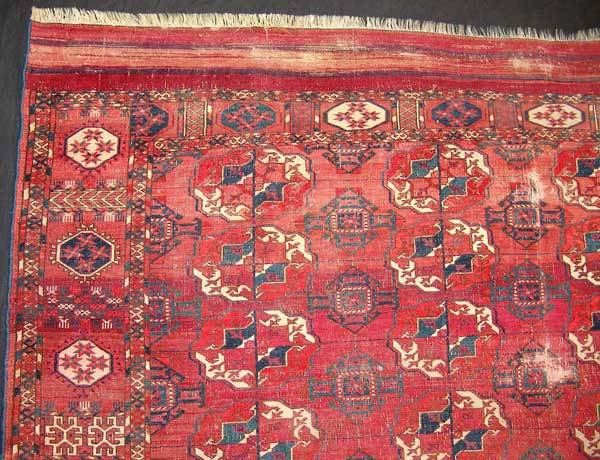
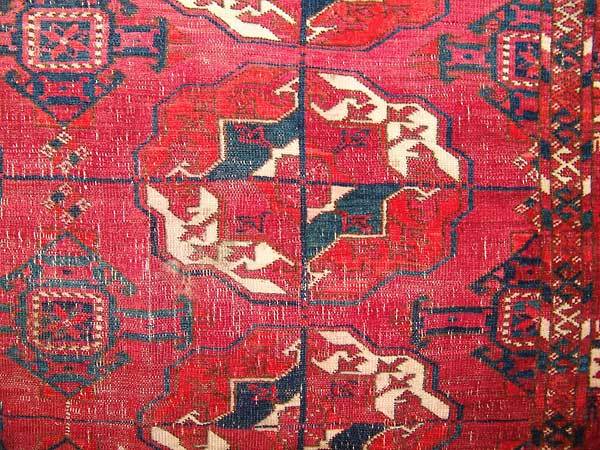
And still the layout fits a
lot of criteria’s for an “old” main carpet:
4 by 10 rows of main
gulls
Non compressed main gulls and octagons
Spacious layout of the main
field
Star and octagon border
Rather simple border surroundings
Great
variation in between the octagons (though symmetric)
Against “old”
age:
The colours
The piled endings
And last perhaps a rather hard
definable mechanical expression. This last mechanical thing is of course a 100%
subjective observation which I could only describe going in to small details of
the drawing. A lack of precision in the motives and perhaps general lack of
variation (and wackiness)
I should perhaps note that the carpet has just
been sold (that’s why I could not post the photos before) and the photos are
from the dealer which photos normally aren’t with oversaturated reds.
I think
it’s a very interesting carpet and if by any chance the happy buyer reads this I
would love to hear his thoughts on the colours.
Regards Martin
Posted by Paul Smith on 05-26-2008 04:18 PM:
Martin--
That is an interesting carpet. Could the pinkish red tone be
cochineal? Maybe there are several different mixes there, since they seem to
have faded to different degrees. That orange sure looks Ponceau-esque, as well.
I would think that this might be the result of a late-19th-c. weaver looking at
an older carpet.
Posted by Martin Andersen on 05-26-2008 04:38 PM:
Hi Paul
Well I wouldn’t think cochineal could be hot like this, but
perhaps.
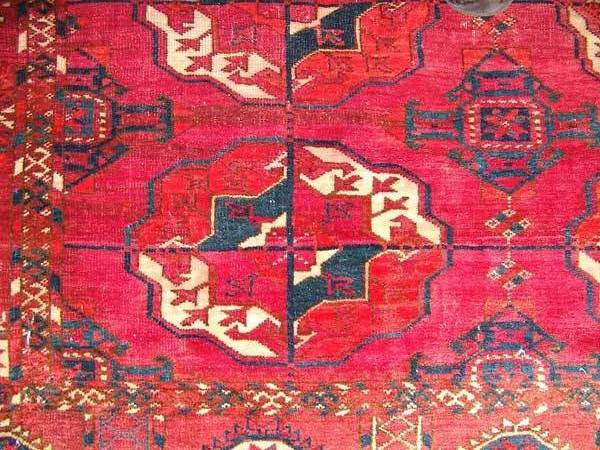

Anyway those wacky Turkmen girls sure had a hot red party with
this rug. Actually I must admit I find the carpets colours very beautiful in a
sort tasteless way 
Regards Martin
Posted by Martin Andersen on 05-26-2008 05:08 PM:
And of course if this synthetic candidate is “very late” it totally wrecks my
own acquired design criteria’s for old age. So I will probably end up agreeing
with Steve that it is almost objectively impossible to date the carpets for
know.
But on the other hand, wrong as it may be, I don’t think I will be able
not to try to establish some kind of subjective gut feeling regarding the age of
the rugs.
Martin
Posted by Alex Wolfson on 05-26-2008 05:55 PM:
One design difference I notice is that the star-filled octagons are more
diamond-shaped, and have more radiata, than the previous examples.
Re:
dyes - good natural orange can be deceptively bright - anyway it is impossible
to tell from digital images.
Tekke mains of the Salor-gul type often have
cerise grounds that looks like cochineal.
Posted by Paul Smith on 05-26-2008 06:00 PM:
Martin--
No, you're right. That would be cochineal on drugs. The
scenario may have been like this: let the sheik visit his pipe for awhile until
he steps outside the tent, and then let's switch this one for his usual old rug.
How the Russians really won Turkestan...
Alex--
I guess it's good
policy to be conservative about digital images, but...that has got to be a hot
orange.
Paul
Posted by Martin Andersen on 05-26-2008 06:04 PM:
"cochineal on drugs"

And Alex, of course you’re
right regarding digital photos, and any photos, colours are difficult. But the
same photographers other rug photos sure do not display oversaturated
reds.
Martin























